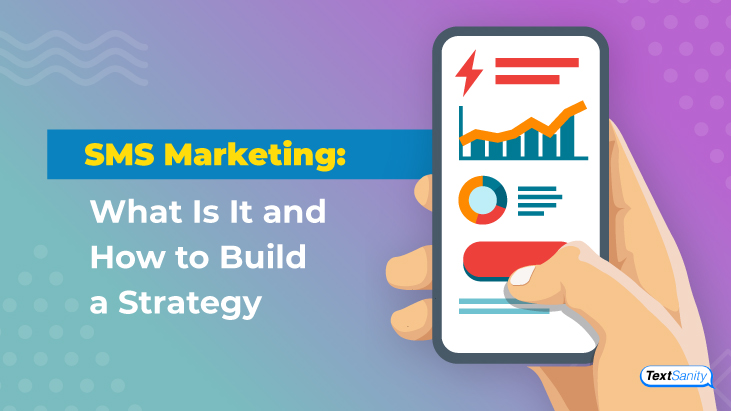SMS Marketing: What is it and How to Build a Strategy
Based on mobile devices’ worldwide use, you are probably very familiar with cell phones and own one yourself. Almost all of the over 5 billion mobile devices being used worldwide are capable of receiving SMS messages, but what is an SMS message?


What is an SMS message?
An SMS message stands for short message service message. You probably know them as text messages. Text messages are a more inclusive term that can also refer to multimedia message service (MMS texts).
Unlike the MMS messages, virtually any mobile device can receive them. The “short” in short message services represents the limited size of an SMS message. SMS messages have a character limit of 160 characters. In other languages, such as Mandarin, the limit is 70 characters.
SMS messages have become one of the most popular forms of communication across all demographics. In fact, Americans now text more than they call.
The number of messages sent per month has increased over the last decade by 7,700%. As the popularity of texting continues to grow, businesses are finding it necessary to incorporate text messaging into their operations.
![]()
What is SMS marketing?
Marketing is the business process of communicating with a company’s customers, potential customers, and the world to promote the selling of the company’s goods and services and the company’s brand image. As a subset of marketing, SMS marketing uses text messages to help reach marketing goals established by the company’s strategic plan.
Typically, SMS marketing is conducted as part of a permission-based marketing approach. Unlike other strategies that rely on cold contacts to seek out potential customers, permission-based marketing is directed towards customers who have requested marketing messages be sent to them.
The customer signs up or opts-in to the marketing campaign and expects to receive the messages. Email marketing uses this same permission-based marketing. The difference in SMS marketing is that the messages are sent by text instead of by email.
As a consumer, you’ve probably experienced SMS marketing before. If you’ve checked the box during checkout to receive promotional coupons by text, you’ve opted-in to a SMS marketing campaign. As you can see from this example, you can use other channels to promote or lead customers to opt-in to your SMS marketing.
![]()
Why should you use SMS marketing?
SMS marketing can work in tandem with other marketing channels to help you achieve your marketing goals. There are several benefits to SMS marketing.

- Direct access – There are very few channels that put you in direct contact with your customer so quickly.
- High open rate – A vast majority of texts are opened and read within the first three minutes of receipt.
- Consistent engagement – With drip campaigns, you can use automated text messages delivered along a strategic timeline to maintain engagement with your customers.
- Conversion contributions – As your customer moves through the marketing process, funnel them from awareness to a purchase. Each step along the way is a conversion, and with direct customer access, SMS marketing helps convert your customers.
- Channel support and compliments. There are lots of marketing channels to use when achieving your marketing goals. SMS marketing is a stand-alone approach, but also works with other channels to give you a diversified approach.
- Cost-effective. SMS marketing offers great ROI. When you employ mass texting, you reach your entire customer database for less than a penny per customer. Given the other benefits, that low cost makes SMS marketing even more appealing.
There’s not a business or industry that can’t benefit from SMS marketing. SMS marketing is beneficial to businesses of all sizes with target markets of various sizes. Given the popularity of SMS messages worldwide, even small businesses can literally go global.
With SMS marketing, your only limitation is your creativity. So, in order to capitalize on text marketing’s benefits, it’s vital to know how to build a strategy that works for your business.
![]()
How to build an SMS marketing strategy
As you build an SMS marketing strategy, there are steps to follow to help you along the way.
Step 1: Develop your main objective
Marketing can help you to achieve different objectives in business. Setting your main objective for SMS marketing should be based on your overall marketing plan. This will help you focus your efforts and set realistic, measurable goals to help you achieve marketing success through text.
Evaluate your marketing channels to intertwine your text marketing goals with other channels to reach desired marketing objectives.
As you contemplate your objectives, ask yourself these questions:
-
What are you trying to accomplish with your SMS marketing?
-
What is your timeline for achieving your goal?
-
How will you measure your SMS marketing’s success?
-
How does this add value to your business, your customers, and your relationship?
In order to ensure continued success, check in with your objectives frequently. See if you’re achieving success or if you need to shift your approach to keep you on track.
Step 2: Determine why your customer will care
Once you know your objectives for SMS marketing, it’s important to evaluate your customer’s needs. It’s great that you have something to say, but think about the following. Why should your customer care? What value are you adding to your customer’s experience through your SMS marketing?

Customers opt-in to receive your messages and remember why they agreed to be marketed to. Knowing your customer helps you to answer certain questions as you prepare your SMS marketing strategy such as:
-
What keeps your customers engaged and open to your messages?
-
Will you add discounts or exclusive deals to your customers?
-
How often will you message customers?
-
What kind of value are you going to add to your customer’s experience?
Some important things to communicate to customers is what kind of messages you’ll send. And how often they expect to receive texts from you. When you establish your message type and frequency, make sure to stick to the expectations you set.
Being honest and sticking to your message type and frequency shows your customers respect and builds trust. As you answer the customer value questions, think of your SMS marketing campaign approach as if you were a customer. Would you subscribe to your campaign based on what you’re planning to offer?
Step 3: Build your database
In order to send your messages, you need to have people to receive them. Use other marketing channels to promote your SMS campaign. Communicate to customers the value you add to their experience. Be sure to communicate the steps they can take to opt-in. Webforms are a great way to help get customers subscribed to your campaign.
Step 4: Develop your message
Now is the time to develop your message. Remember to be short and to the point in your messages. Depending on your objective, give customers an immediate call to action. Remember to include how it adds value through a discount code or giveaway.

It’s important to follow a few simple rules in your message development.
- Keep it short.
- Announce yourself.
- Be direct.
- Avoid abbreviations.
- Avoid emojis.
- Always proofread.
- Provide opt-out option information.
Once you have your message written, you’re ready for the last step.
Step 5: Hit send
When you understand the why, who, and what of your message, you’re ready to send the message. Remember to send timely messages. Additionally, use your metrics to determine your campaign’s success.

Only about 40% of businesses offer text communications to customers. However, almost 80% of customers prefer to communicate with businesses through text. Now is the time to meet customer’s expectations. So, hitting send and getting started with your SMS marketing campaign gives your company a huge competitive advantage.
Summary
Only you decide if SMS marketing is right for your company. Understanding what SMS marketing is and how to build a strategy that achieves your marketing objectives is crucial. As you evaluate needs, remember SMS marketing’s many applications, uses, and benefits. It’s likely that SMS marketing helps every part of your business.


